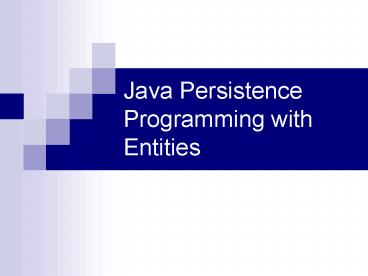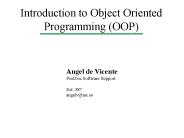Java Persistence Programming with Entities - PowerPoint PPT Presentation
1 / 21
Title:
Java Persistence Programming with Entities
Description:
Accessing Entities in the Persistence Context. persistence.xml ... Can handcraft, or use tools like Hibernate, TopLink, etc. ORM Example. What is an Entity? ... – PowerPoint PPT presentation
Number of Views:186
Avg rating:3.0/5.0
Title: Java Persistence Programming with Entities
1
Java Persistence Programming with Entities
2
What Well Cover
- Overview
- ORM
- ORM Example
- What is an Entity?
- Entities vs Session Beans
- Entity classes
- Accessing Entities in the Persistence Context
- persistence.xml file
- EntityManager API
- Entity Life Cycle
- Entity Life Cycle Diagram
- Life-cycle call backs
- Entity Synchronization
- Transaction Isolation
- Tuning for concurrent access
- Dirty Read
- Unrepeatable Read
- Entity Lookup and Query API
3
Overview
- Java Persistence provides
- Standard OR mappings
- Not tied to the J2EE container
- Defines an SPI so different service providers can
be used
4
ORM
- Simplest Java Serialization objects written
to files - Store Java Objects in RDBMS (JDBC maps your
object data to DB) - ORM- Object Relational Mapping
- Can have arbitrary queries for information
- Can visually inspect data
- Can handcraft, or use tools like Hibernate,
TopLink, etc.
5
ORM Example
6
What is an Entity?
- Two different kinds of objects application
logic and persistent data - Persistent data can be saved to storage by
persistence mechanisms - Called entities in Java Persistence Specification
- Store data as fields and have getters/setters
- Can group related data into coherent objects and
factor out common attributes in inheritance
hierarchy
7
Entities vs Session Beans
- Entities have a client-visible persistent
identity - Entities have a visible state
- Entities are not remotely acessible
- Entities lifetimes are independent of
applications lifetime - Entities are translated back and forth by the
persistence provider
8
Entity classes
- Entity is a POJO (can implement Serializable so
it can be used as a data record) - Entity maps to a definition in an RDBMS
- Must have a primary key
- Access via direct field state or setter/getter
- Entity can expose business methods
9
Accessing Entities in the Persistence Context
- Clients must retrieve entity from the persistence
context or create one - Persistence context connection between in
memory instances and the database EntityManager
API - Persist() method puts an entity into the managed
state - Transaction scoped context Persistence Context
ends with enclosing txn - Extended persistence context ends when
enclosing stateful bean is removed by the
container (managed across several invocations - Detached state entities have no connection with
a entity manager and are not synchronized with
the DB - Detached entities have to be retrieved by id
(reattached or merged into new context).
10
persistence.xml file
- Must have persistence-unit element with name
attribute - Example
- ltpersistencegt
- ltpersistence-unit name"manager1"gt
- ltdescriptiongtps unit onelt/descriptiongt
- ltjta-data-sourcegtjava/DefaultDSlt/jta-data-sourcegt
- ltmapping-filegtormap2.xmllt/mapping-filegt
- ltexclude-unlisted-classes/gt
- ltjar-filegt../MyApp.jarlt/jar-filegt
- ltclassgtorg.acme.Employeelt/classgt
- ltpropertiesgt
- ltproperty name"hibernate.dialect"
value"org.hibernate.dialect.HSQLDialect"/gt - lt/propertiesgt
- lt/persistence-unitgt
- lt/persistencegt
11
EntityManager API
- Container-managed injected via
_at_PersistenceContext - Application-managed created via
EntityManagerFactory - Three types of operations
- Life-cycle management
- DB synchronization
- Entity lookup/queries
12
Entity Life Cycle
- new entity instance created in memory, not
associated with persistence identity or context
(right after creation) - managed has a persistent identity, changes are
synched w/ DB (after persist()) - detached does have a persistent id but not
associated with a persistence context - removed associated with a context, but is
scheduled for removal from the DB (after remove()
illegal on a detached entity)
13
(No Transcript)
14
Life-cycle call backs
- _at_PrePersist
- _at_PostPersist
- _at_PreRemove
- _at_PostRemove
- _at_PreUpdate
- _at_PostUpdate
- _at_PostLoad
- Can also define separate listener classes
- _at_EntityListeners(MyListener.class)
- Callback methods for listeners takes an entity
argument
15
Entity Synchronization
- SetFlushMode
- COMMIT default synchronize entities in
context at commit - AUTO at commit and before query execution
- Flush() synchs the state of all entities in the
context, but does not refresh from DB
16
Transaction Isolation
- Protected by transaction isolation
- Container-managed txns use isolation levels
configured by persistence provider or containers
txn service - SERIALIZABLE max txn isolation, may degrade
performance - READ UNCOMMITTED may lead to inconsistent
data/bad behavior
17
Tuning for concurrent access
- Optimistic locking using _at_Version
- Not done by default
- Checks for version of entity before updates
- Globally set stricter txn isolation
- Application level locks
- manager.lock(account LockMode.WRITE)
- READ prevents dirty/non-repeatable reads
- WRITE READ plus forces an increase in the
version number (if any)
18
Dirty Read
19
Unrepeatable Read
20
Entity Lookup and Query API
- Find by primary key with the EntityManager.find()
- Create a query
- Get a javax.persistence.Query from the EM
- Customize (if needed) query params/result set
limits - Execute
- EM.createQuery EJB QL or createNativeQuery
standard SQL - Named query
- _at_NamedQuery (namename queryStringqueryString
21
What We Covered
- Overview
- ORM
- ORM Example
- What is an Entity?
- Entities vs Session Beans
- Entity classes
- Accessing Entities in the Persistence Context
- persistence.xml file
- EntityManager API
- Entity Life Cycle
- Entity Life Cycle Diagram
- Life-cycle call backs
- Entity Synchronization
- Transaction Isolation
- Tuning for concurrent access
- Dirty Read
- Unrepeatable Read
- Entity Lookup and Query API































